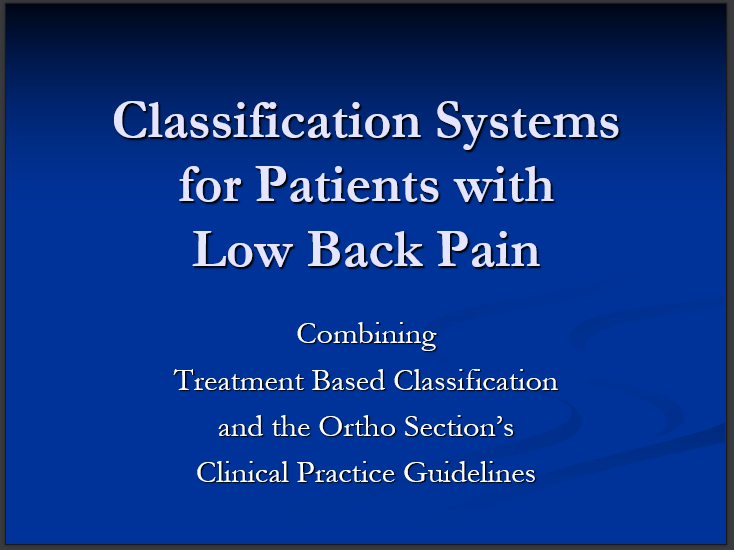Combining Treatment Based Classification and the Ortho Section’s Clinical Practice Guidelines
Low back pain cannot be managed as a single entity. Classification of patients with low back pain into distinct subgroups has been shown to improve outcomes. However, many different classification systems exist and lead to some confusion as to the best approach. This course looks at 2 commonly used classification systems, Treatment Based Classification and the Orthopaedic Section’s Clinical Practice Guidelines, and combines them into a useful, clinical approach. The course also reviews determining the suitability of physical therapy treatments, including recognizing medical concerns and nonorganic pain.
Duration: one hour
Instructor: Scott A. Biely, PT, DPT, PhD
Course Objectives:
- Recognize the necessity of classification in treating low back pain.
- Identify different classification systems.
- Describe the Treatment Based Classification System, including suitability, staging, and syndromes.
- Recognize medical conditions that would take precedence over physical therapy treatment.
- Understand how to determine the nonorganic component of a patient’s pain.
- Describe the Ortho Section’s Clinical Practice Guidelines.
- Understand the strengths and weaknesses of both classification systems and describe how the 2 can be used clinically.
References
- Baker DJ, Pynsent PB, Fairbank JCT. The Oswestry Disability Index revisited: its reliability, repeatability and validity, and a comparison with the St Thomas Disability Index. In: Roland M, Jenner JR, eds. Back pain: new approaches to rehabilitation and education. Manchester: Manchester University Press; 1989. 174–86.
- Bowling RW, Truschel DW, Delitto A, Erhard RE. Conservative Management of Low Back Pain with Physical Therapy. In Cumulative Trauma Disorders. Erdil M, Dickerson OB eds. New York, NY: Van Nostrand Reinhold; 1997.
- Brennan GP, Fritz JM, Hunter SJ, Thackeray A, Delitto A, Erhard RE. Identifying subgroups of patients with acute/subacute "nonspecific" low back pain: results of a randomized clinical trial. Spine. 2006; 31:623-31.
- Delitto A, George SZ, Van Dillen L, Whitman JM, Sowa G, Shekelle P, Denninger TR, Godges JJ. Low back pain: clinical practice guidelines linked to functioning, disability, and health from the Orthopaedic Section of the American Physical Therapy Association. J Orthop Sports Phys Ther. 2012;42(4):A1-A57.
- Flynn T, Fritz J, Whitman J, Wainner R, Magel J, Rendeiro D, Bulter B, Garber M, Allison S. A clinical prediction rule for classifying patients with low back pain who demonstrate short-term improvement with spinal manipulation. Spine. 2002;27(24):2835-43.
- Fritz JM, Irrgang JJ. A comparison of a modified Oswestry Low Back Pain Disability Questionnaire and the Quebec Back Pain Disability Scale. Phys Ther. 2001;81(2):776–88.
- Frymoyer JW, Andersson GBJ. Clinical Classification. In Occupational Low Back Pain. Pope MH, Andersson GBJ, Frymoyer JW, Chaffin DB eds. St. Louis, MO: Mosby Year Book; 1991; 44-70.
- Goodman CC, Boissonnault WG, Fuller KS. Pathology: Implications for the Physical Therapist. Philadelphia: Saunders, 2003.
- Hicks GE, Fritz JM, Delitto A, Mcgill SM. Preliminary development of a clinical prediction rule for determining which patients with low back pain will respond to a stabilization exercise program. Arch Phys Med Rehabil. 2005;86(9):1753-62.
- Riddle DL. Classification and Low Back Pain: A Review of the Literature and Critical Analysis of Selected Systems. Phys Ther. 1998; 78(7):708-737.


